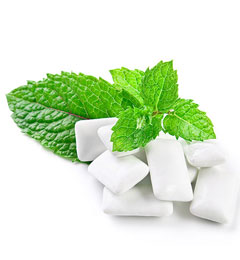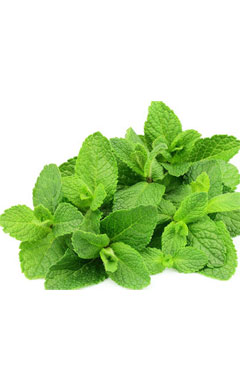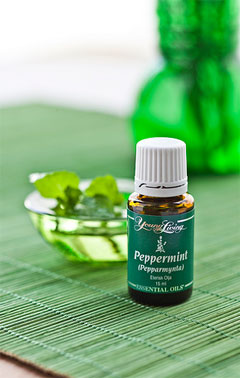|
|
Peppermint: A Power House of Health Benefits

Mint descends from the Latin word mentha, which is rooted in the Greek word
minthe, personified in Greek mythology as Minthe, a nymph who was transformed
into a mint plant. The word itself probably derives from a now extinct pre-Greek
language. Mint leaves, without a qualifier like peppermint or apple mint,
generally refers to spearmint leaves.
In Spain, Central and South America, mint is known as hierba buena (literally,
"good herb"). In Lusophone countries, especially in Portugal, mint species are
popularly known as Hortel�. In many Indo-Aryan languages, it is called Pudina.
The taxonomic family Lamiaceae is known as the mint family. It includes many
other aromatic herbs, including most of the more common cooking herbs, including
basil, rosemary, sage, oregano, and catnip. As an English colloquial term, any
small mint-flavored confectionery item can be called a mint. In common usage,
other plants with fragrant leaves may be called "mint" although they are not in
the Mint Family. Vietnamese Mint, commonly used in Southeast Asian cuisine is
Persicaria odorata in the family Polygonaceae, collectively known as smartweeds
or pinkweeds. "Mexican mint marigold" is Tagetes lucida in the sunflower family
(Asteraceae).
Mentha also known as Mint is a genus of plants in the family Lamiaceae. The
species are not clearly distinct and estimates of the number of species varies
from 13 to 18. Hybridization between some of the species occurs naturally. Many
other hybrids as well as numerous cultivars are known in cultivation. The genus
has a subcosmopolitan distribution across Europe, Africa, Asia, Australia and
North America.
Mints are aromatic, almost exclusively perennial, rarely annual, herbs. They
have wide-spreading underground and overground stolons and erect, square,
branched stems. The leaves are arranged in opposite pairs, from oblong to
lanceolate, often downy, and with a serrate margin. Leaf colors range from dark
green and gray-green to purple, blue, and sometimes pale yellow. The flowers are
white to purple and produced in false whorls called verticillasters. The corolla
is two-lipped with four subequal lobes, the upper lobe usually the largest. The
fruit is a nutlet, containing one to four seeds.
While the species that make up the Mentha genus are widely distributed and can
be found in many environments, most Mentha grow best in wet environments and
moist soils. Mints will grow 10�120 cm tall and can spread over an indeterminate
area. Due to their tendency to spread unchecked, mints are considered invasive.
All mints prefer, and thrive near pools of water,lakes,rivers,cool, moist spots
in partial shade. In general, mints tolerate a wide range of conditions, and can
also be grown in full sun. They are fast growing, extending their reach along
surfaces through a network of runners. Due to their speedy growth, one plant of
each desired mint, along with a little care, will provide more than enough mint
for home use. Some mint species are more invasive than others. Even with the
less invasive mints, care should be taken when mixing any mint with any other
plants, lest the mint take over. To control mints in an open environment, mints
should be planted in deep, bottomless containers sunk in the ground, or planted
above ground in tubs and barrels.
Some mints can be propagated by seed. Growth from seed can be an unreliable
method for raising mint for two reasons: mint seeds are highly variable - one
might not end up with what one presupposed was planted; and some mint varieties
are sterile. It is more effective to take and plant cuttings from the runners of
healthy mints.
The most common and popular mints for cultivation are peppermint (Mentha �
piperita), spearmint (Mentha spicata), and (more recently) apple mint (Mentha
suaveolens).
 The leaf, fresh or dried, is the culinary source of mint. Fresh mint is usually
preferred over dried mint when storage of the mint is not a problem. The leaves
have a warm, fresh, aromatic, sweet flavor with a cool aftertaste. Mint leaves
are used in teas, beverages, jellies, syrups, candies, and ice creams. In Middle
Eastern cuisine, mint is used on lamb dishes, while in British cuisine and
American cuisine, mint sauce and mint jelly are used, respectively. The leaf, fresh or dried, is the culinary source of mint. Fresh mint is usually
preferred over dried mint when storage of the mint is not a problem. The leaves
have a warm, fresh, aromatic, sweet flavor with a cool aftertaste. Mint leaves
are used in teas, beverages, jellies, syrups, candies, and ice creams. In Middle
Eastern cuisine, mint is used on lamb dishes, while in British cuisine and
American cuisine, mint sauce and mint jelly are used, respectively.
Mint is a necessary ingredient in Touareg tea, a popular tea in northern African
and Arab countries. Alcoholic drinks sometimes feature mint for flavor or
garnish, such as the mint julep and the mojito. Cr�me de menthe is a
mint-flavored liqueur used in drinks such as the grasshopper.
Mint essential oil and menthol are extensively used as flavorings in breath
fresheners, drinks, antiseptic mouth rinses, toothpaste, chewing gum, desserts,
and candies; see mint (candy) and mint chocolate. The substances that give the
mints their characteristic aromas and flavors are menthol (the main aroma of
Peppermint and Japanese Peppermint) and pulegone (in Pennyroyal and Corsican
Mint). The compound primarily responsible for the aroma and flavor of spearmint
is R-carvone. Mints are used as food plants by the larvae of some Lepidoptera
species including Buff Ermine.
Mint was originally used as a medicinal herb to treat stomach ache and chest
pains, and it is commonly used in the form of tea as a home remedy to help
alleviate stomach pain. In Rome, Pliny recommended that a wreath of mint was a
good thing for students to wear since it was thought to "exhilarate their
minds". During the Middle Ages, powdered mint leaves were used to whiten teeth.
Mint tea is a diuretic. A common use is as an antipruritic, especially in insect
bite treatments (often along with camphor). The strong, sharp flavor and scent
of mint is sometimes used as a mild decongestant for illnesses such as the
common cold.
Mint is also used in some shampoo products. Menthol from mint essential oil
(40�90%) is an ingredient of many cosmetics and some perfumes. Menthol and mint
essential oil are also much used in medicine as a component of many drugs, and
are very popular in aromatherapy. Menthol is also used in cigarettes as an
additive, because it blocks out the bitter taste of tobacco and soothes the
throat.
Although it is used to treat many symptoms, mint can also cause allergic
reactions to some people. Although rare, these can induce painful symptoms
including abdominal cramps and diarrhoea, headaches, tingling or numbing around
the mouth, nasal congestion, clogging of the sinuses, nausea, etc. It can be a
reaction to Salycilates or Linalol contained in the mint, or to some of the
proteins inside the plant. It is possible to have high intolerance to one type
of mint such as spearmint yet have no reaction to other types such as peppermint
and menthol, and the symptoms may get worse over time. Because it is uncommon,
the people who suffer from mint allergies can find it hard to deal with it on a
daily basis. Most of the problems arise from the need to find special toothpaste
or dental products, but can also be reactions to the smell of somebody consuming
mint candy or gum in a public or work place. In some cases it can be a minor
disturbance but sometimes a severe reaction: because it is potent, inhaling the
mint can trigger by itself breathing problems, nausea and dizziness separately
or all together. Depending on whether the allergy is to a chemical or a protein
inside the plant, it may or may not extend to other Lamiaceae. iFood.tv claims
that the American Allergy and asthma Foundation has tracked an increasing amount
of mint allergies as with allergies in general.
Mint oil is also used as an environmentally friendly insecticide for its ability
to kill some common pests like wasps, hornets, ants and cockroaches. Known in
Greek mythology as the herb of hospitality, one of mint's first known uses in
Europe was as a room deodorizer. The herb was strewn across floors to cover the
smell of the hard-packed soil. Stepping on the mint helped to spread its scent
through the room. Today, it is more commonly used for aromatherapy through the
use of essential oils.
Health benefits of peppermint
-
 One of the major health benefits of mint leaves is the effect on the
body's digestive system. Rich aroma, can activate the salivary glands and
the digestive enzymes in our body., In western countries mint made
appetizers. One of the major health benefits of mint leaves is the effect on the
body's digestive system. Rich aroma, can activate the salivary glands and
the digestive enzymes in our body., In western countries mint made
appetizers.
Mint leaves can also be used to treat indigestion and stomach. When you are
sick stomach, you can drink a cup of mint tea. Aroma Mint is also useful for
treating nausea and headaches. Menthol oil derived from the leaves of Mint
widely used people who often travel far to prevent nausea.
-
Mint oil is a stimulant, so it may be useful in treating depression,
stress and headaches. You can use soap in the bath or aroma mint mint oil
dripping into your pillow so you can breathe.
-
Mint can help you lose weight, because it stimulates the digestion of
fat! You can chop the mint leaves and add them to an omelet or tea.
-
Strong mint scent also provides health benefits to the respiratory
system and is used to treat a variety of respiratory disorders. It is very
effective as a decongestant nose, throat, bronchi and lungs, and treating
respiratory disorders such as asthma and cough.
-
Mint leaves also has the functions and benefits for oral health. Mint
leaves are often used to treat oral health, because mint has antimicrobial
properties. You just chew mint leaves to fight the growth of harmful
bacteria in the mouth, teeth and tongue.
-
Mint is also good for skin health, so it is often used to treat acne,
insect bites, and burns. In addition, the mint leaves are also used as a
condiment and decorative items that are used in a variety of culinary dishes
and drinks.
-
Mint contains numerous plant derived chemical compounds that are known
to have been anti-oxidant, disease preventing and health promoting
properties. Total antioxidant strength (ORAC) of fresh peppermint herb is
13978 �mol TE/100 g.
-
The mint herb contains no cholesterol; however, it is rich in essential
oils, vitamins and dietary fiber, which helps to control blood cholesterol
and blood pressure inside the human body.
-
The herb parts contain many essential volatile oils like menthol,
menthone, menthol acetate. These compounds effect on cold-sensitive
receptors in the skin, mouth and throat, the property which is responsible
for the natural cooling-sensation that it initiates when inhaled, eaten, or
applied on the skin.
The essential oil, menthol also has been analgesic (painkiller), local
anesthetic and counter-irritant properties.
-
Research studies have also been suggested that the compounds in the
peppermint relax intestinal wall and sphincter smooth muscles through
blocking calcium channel at cell receptor levels. This property of mint has
been applied as an anti-spasmodic agent in the treatment of "irritable bowel
syndrome" (IBS) and other colic pain disorders.
-
Peppermint-herb is an excellent source of minerals like potassium,
calcium, iron, manganese and magnesium. 100 g fresh herb provides 569 mg of
potassium. Potassium is an important component of cell and body fluids that
helps control heart rate and blood pressure. Manganese and copper works as
co-factors for the antioxidant enzyme, superoxide-dismutase.
-
 Mint is rich in many antioxidant vitamins, including vitamin A, beta
carotene, vitamin-C and vitamin E. The leaves of mint also contain many
important B-complex vitamins like folates, riboflavin and pyridoxine
(vitamin B-6); and the herb is an excellent source of vitamin-K. Mint is rich in many antioxidant vitamins, including vitamin A, beta
carotene, vitamin-C and vitamin E. The leaves of mint also contain many
important B-complex vitamins like folates, riboflavin and pyridoxine
(vitamin B-6); and the herb is an excellent source of vitamin-K.
Research on potential health benefits of peppermint tea
Peppermint (Mentha piperita L.) is one of the most widely consumed single
ingredient herbal teas, or tisanes. Peppermint tea, brewed from the plant
leaves, and the essential oil of peppermint are used in traditional medicines.
Evidence-based research regarding the bioactivity of this herb is reviewed. The
phenolic constituents of the leaves include rosmarinic acid and several
flavonoids, primarily eriocitrin, luteolin and hesperidin. The main volatile
components of the essential oil are menthol and menthone. In vitro, peppermint
has significant antimicrobial and antiviral activities, strong antioxidant and
antitumor actions, and some antiallergenic potential.
Animal model studies demonstrate a relaxation effect on gastrointestinal (GI)
tissue, analgesic and anesthetic effects in the central and peripheral nervous
system, immunomodulating actions and chemopreventive potential. Human studies on
the GI, respiratory tract and analgesic effects of peppermint oil and its
constituents have been reported. Several clinical trials examining the effects
of peppermint oil on irritable bowel syndrome (IBS) symptoms have been
conducted. However, human studies of peppermint leaf are limited and clinical
trials of peppermint tea are absent. Adverse reactions to peppermint tea have
not been reported, although caution has been urged for peppermint oil therapy in
patients with GI reflux, hiatal hernia or kidney stones.
This research was done by McKay DL, Blumberg JB. source USDA Human Nutrition
Research Center on Aging at Tufts University, 711 Washington St., Boston, MA
02111, USA.
Dated 14 October 2013
|
|
|
|
|









